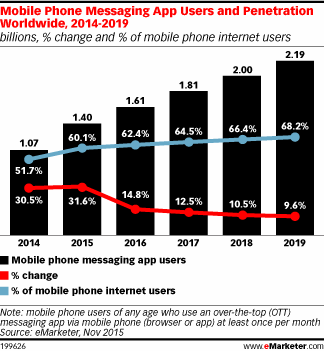The future is mobile. Internet traffic is now coming more from mobile devices than desktops. 56% of traffic online comes from a mobile device. If you’re not catering your content, ads and online experience to a mobile user, then you are missing a massive opportunity. Mobile continues to be the marketer’s medium of focus, with mobile increasingly subsuming the overall digital advertising landscape. 71% of marketers believe mobile marketing is core to their business.
Mobile marketing and customer loyalty are not new ideas or tactics, but the strategy behind them has been evolving dramatically over the past few years, and that momentum is going to continue through 2017.
Here are some of the trends that are going to affect every brand’s mobile strategy in 2017:
1) Content messaging becomes mainstream:
Branded content is playing more of a role than ever before. Brands are experiencing greater engagement in messaging apps than through traditional mobile advertising. It’s all about delivering high-quality, shareable content that resonates with users.
2) The Growth of Video:
The use of video grew in 2016, but seems set to explode in 2017. Why? Because it’s that effective. Want more reach? Use video. Want more leads? Use video. Want more sales? You got it: Use video. Short videos are best when they catch attention but don’t waste time; if you make them an engaging series, they bring consumers back for more.
3) Omnichannel:
53 percent of consumers feel that it’s important for retailers to recognize them as the same person across all channels and devices used to shop, and 78 percent are also willing to allow retailers to use information from their in-store purchases to provide a more personalized experience.
Brands and marketers need to start giving consumers that they want—omnichannel, personal experiences.
Hearing it straight from the consumer’s mouth, 2017 will be a year for customers to be treated as individuals, with a consistent brand experience regardless of what channel they’re using. By creating a single view of the customer, brands can ensure that they are not only following the journey across all platforms and channels but also reacting to it at the points of highest value.
4) Bots/Chatbots:
As more consumers communicate with brands via social media and messaging apps, the need for brands to respond to would-be customers in a timely manner has grown increasingly important. Chatbots which use both artificial intelligence and machine learning, according to Jes Stiles “allow you to have personalized 1–1 conversations at scale, opening up a whole new audience who does not wish to connect with the brand over email or download an app.” More people use messaging apps today than they do social media, according to Business Insider, and adoption continues to increase rapidly.
In 2016, Facebook slowly opened up Messenger to automated bots and the ability to natively pay for services, but the experiences were undercooked and over hyped. WeChat has long been at the forefront of what is possible in creating an ecosystem atop messaging – and others will inevitably follow.

5) Location-based services in retail:
2017 may be the year we finally see actual widespread implementations and usage of beacons and other location-based technologies. In particular, in-store implementations will provide consumers with enhanced shopping experiences.
6) Single view Technology:
The old days of mass campaign emails pushed out through legacy marketing stacks are behind us now. According to McKinsey & Co., 83 percent of marketers identify that the ability to make data-guided decisions is one of the most important capabilities, but only 10 percent believe they are effective at feeding insights about customer behaviors back into the organization to improve performance.
Measuring campaign success on whether or not an email was opened won’t cut it anymore. Companies need to have a single view of online and offline systems across multiple channels so that they can build single, operational profiles for each customer.
7) The Mobile Messaging space continued to grow:
In terms of growth in general, in 2015 1.4 billion consumers used mobile messaging. That number is expected to be 2.19 billion consumers by 2019, according to eMarketer. Mobile messaging is clearly here to stay.

2017 will pave the path for becoming agiler and making data real-time and actionable in the mobile-first world. Behavioural and transactional data and syncing individual profiles will be the only way to reach customers, not through campaigns built for large masses. Companies need to make sure to integrate their technologies to make their once singular marketing stack more agile, real-time and actionable.




